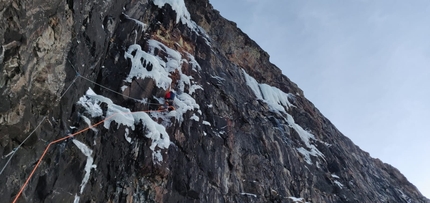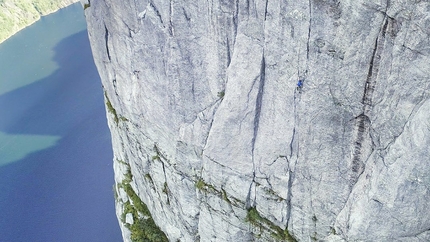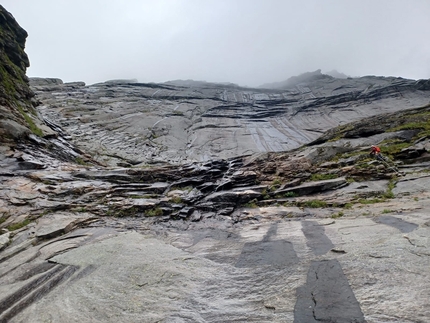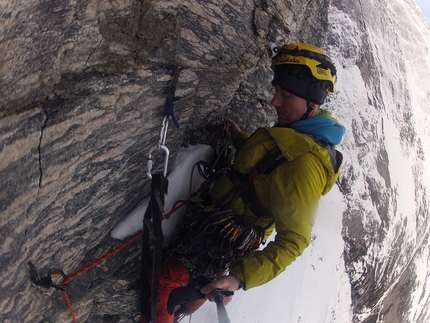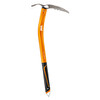Stetind 'South West Face' first ascent in Norway by Joda Dolmans, Andreas Widlund

 1 / 5
1 / 5 Joda Dolmans archive
Joda Dolmans archive
Stetind is special in many ways. With its vertical and anvil-like shape, it rises straight out of the ocean. For sailors along the coast, it’s a well-known landmark and in 2002 Stetind was selected as Norway’s national mountain. This proud piece of rock is located in the municipality of Tysfjord, about 90km south of Narvik.
Stetind has a long climbing history that dates all the way back to 1910. Nowadays there are many routes on the mountain, unsurprisingly therefore are also a few super high-quality ones. Classics such as Sydpilaren and Vest Veggen – Vest eggen see a lot of visitors during good weather periods, while Normalveien is the easiest way up the mountain and also a popular route for guiding. Having said that, it is also true that some existing routes see very few repeats and information can be hard to get.
Over the years many climbers have fallen in love with Stetind due to its beautiful shape and good quality rock, and consequently most parts of the mountain have been explored and examined carefully. But if you look close enough, this vast ocean of rock is full of empty sections between existing lines.
Trying a new route on such an iconic peak involves putting in a lot of work. Not only climbing-wise, but beforehand, figuring out what’s already been done and what has not. In the end, the experience of climbing into unexplored terrain counts more than claiming the "First Ascent". Bearing this in mind, I think we managed fairly well to trace our own line up a mysterious face, on perhaps one of Norway’s biggest climbing stages.
Andreas Widlund and I spontaneously bumped into each other while waiting for the ferry to Lofoten. Full of excitement, Andreas told me that he had just been to Stetind, scouting and rope-soloing a few pitches on the SW face. 80m up the face, the corner he had been following suddenly disappeared and blank slabs forced him back down. "I’m sure it goes in some way! Plus, I’ve never seen it this dry" he said with a grin. Without any fixed plans for the next days and given the opportunity, we quickly realised that the only sensible thing was to drive back to Stetind and give it a proper try, together. An opportunity too good to say no to! This face had been on my mind for a few years and a lot longer for Andreas.
After sleeping under a large boulder at the base of the wall for a few hours, we racked up and started up the first pitch (June 30th around 5.30 pm). We planned to climb through the night and the next day, and longer if needed. 80 meters up we arrived at Andreas’ previous highpoint where we climbed a tricky and partly bold slab traverse to reach another corner system. Later, this would turn out to be the crux of the entire route at N7 (6c+). For countless hours we searched our way higher and higher up the face, freeing every pitch, onsight. At times we took a wrong turn, ending up doing so scary downclimbing or run-out traverses. But spirits were high and we felt very fortunate to have been given the opportunity to climb in such a cool setting. After 33 hours on the go, with two longer breaks, we topped out, happy and very tired after a long time on the wall and from climbing through uncertainty.
Our route climbs straight up the highest part of the face. In the middle we seemed to have crossed an existing route (Guldfisken, by Tommy Nilsson & Hans Lindberg). We encountered difficulties up to N7 (6c+) as well as one A0 section on the very last pitch. The route offers everything from tricky slabs and runouts to well-protected corners and steep cracks. The quality of the rock was mostly good with occasionally wet sections and loose blocks. All in all, it was everything we could have asked for. It felt very real! We named our route South West Face.
By Joda Dolmans



 Copia link
Copia link

